Here’s my guide to Andrea Mantegna’s famous Camera degli Sposi in Mantua Italy.
The Camera is a magical room frescoed with illusionistic paintings in Mantua’s Ducal Palace. It’s considered a hugely influential masterpiece from the early Renaissance.
The fresco is famous for being the first trompe l’oeil in the history of painting. This is an optical illusion that tricks the viewer into believing that the objects depicted in the painting are real and three dimensional.
For its beauty and uniqueness, the Camera became a designated UNESCO site in 2008. To fully appreciate the beauty of the room, it’s a good idea to book a guide tour.
Mantua itself is one of Italy’s most beautiful towns and one of Europe’s best kept secrets. Mantua lies in northern Italy in the Lombardy region, surrounded by three lakes. It’s a fairly easy day trip from Milan or Verona (even Venice by car).
You may have a hazy recollection of Mantua from literature and lore.
Storied Mantua was referenced by Virgil in Dante’s Divine Comedy. In Shakespeare’s Romeo and Juliet, Mantua was the town where Romeo fled and purchased poison. In the Verdi opera Rigoletto, the hunchbacked Rigletto served as court jester for the Gonzaga family in Mantua.
What makes Mantua especially dreamy is its Renaissance architecture. It came courtesy of the aristocratic Gonzaga family. They ruled Mantua for four centuries.
But the Gonzaga needed an artist to decorate their magnificent edifices. With ample persuasion, they managed to lure the esteemed painter Andrea Mantegna away from Padua.
READ: One Day in Mantua Itinerary
Andrea Mantegna, Court Artist of the Gonzaga Family
Artist Andrea Mantegna bridged the Early and High Renaissance periods. He was a pioneer of spatial illusionism. He used visual distortions to create uncanny effects of 2D and 3D images on flat surfaces.
His works reflect a perfectionist love of detail. He produced paintings with admirably finished appearances but required slow and painstaking work.
By far Mantegna’s most famous piece is his fresco cycle in the Palazzo Ducale, the Camera degli Sposi. It’s one of the most famous fresco cycles from the 15th century. Painted episodically between 1465 and 1474, the frescos decorate the reception room of the Ducal Palace.
The work was commissioned by the Marquis of Mantua, Ludovico III Gonzaga, a successful soldier and head of the ruling family of Mantua. Ludovico sought to add a cultural flourish to his military success.
Mantegna grew up in Padua, which was also home to Giotto and Donatello. Mantegna’s first important work of art was the frescos in Padua’s Church of the Eremitani, next to the Scovegni Chapel.
The surviving frescos are impressive for an artist of only 17. They catapulted Mantegna to fame. Gonzaga began courting Mantegna to come to Mantua as a court artist.
Mantega was hesitant. Becoming a court artist meant performing menial tasks below the status of an established artist.
For example, you might have to design stage sets for a theater performance. (Leonardo da Vinci did this in Milan for his patron the Duke of Sforza.) Gonzaga promised to limit the drudge work and gave Mantegna creative freedom.
Persuaded, in 1459, Mantegna moved to Mantua. Thus began one of the greatest patron-artist duos of all time. Mantegna spent half a century in Mantua, eventually dying there and being interred in the 15th century Basilica of Sant’Andrea.
Mantua’s Ducal Palace
The Ducal Palace is enormous, one of the largest in Italy. It’s essentially a private city interconnected by courtyards, corridors, and staircases.
It’s nicknamed the “Gonzaga Realm.” Within the walls of this palace-fortress lies the history of the Gonzaga family, its art-filled apartments, and what’s left of the treasures they collected.
READ: The Secret Palace Museums of Rome
The most important thing in the sprawling palace is Mantegna’s masterpiece — the Camera degli Sposi. “Camera” means room and “Sposi” means newlyweds. However, it’s unclear what connection the room has to wedded bliss.
The Camera is located in the north tower of the Castle San Giorgio, part of the Ducal Palace. The storytelling frescos contain portraits of the Gonzaga family, with a vivid and revealing look at court life in the 15th century.
The room was nicknamed the Camera Picta or Painted Room. Mantegna effectively transformed the small interior room into an elegant open air pavilion. Because of the family frescos, visitors could actually “meet” the Gonzagas before a face-to-face meeting.
Guide To The Frescos of the Camera degli Sposi
The frescos on the walls were painted using a combination of buon (true) fresco with walnut oil on plaster. The ceiling was painted in buon fresco.
The ceiling is thus better preserved than the walls, which have needed significant restoration over the years. The two undecorated walls are enclosed in false gold curtains that resemble brocade.
Here are the highlights and what to see inside Mantegna’s Camera degli Sposi:
1. Northern Wall: Court Scene
The Camera’s most famous scene is above the fireplace on the north wall. It’s a long horizontal scene. One the left side you see a man in a pink house coat, with the family dog at his feet. That, in fact, is Ludovico III. It’s a snapshot of daily life, when the family is at their ease.
Ludovico is interrupted with business by his right hand man whispering in his ear. We know it’s important because to the right you see Ludovico’s wife, Barbara of Brandenburg, with a concerned look. She knows something “is up” because of the attention Ludovico’s giving the note.
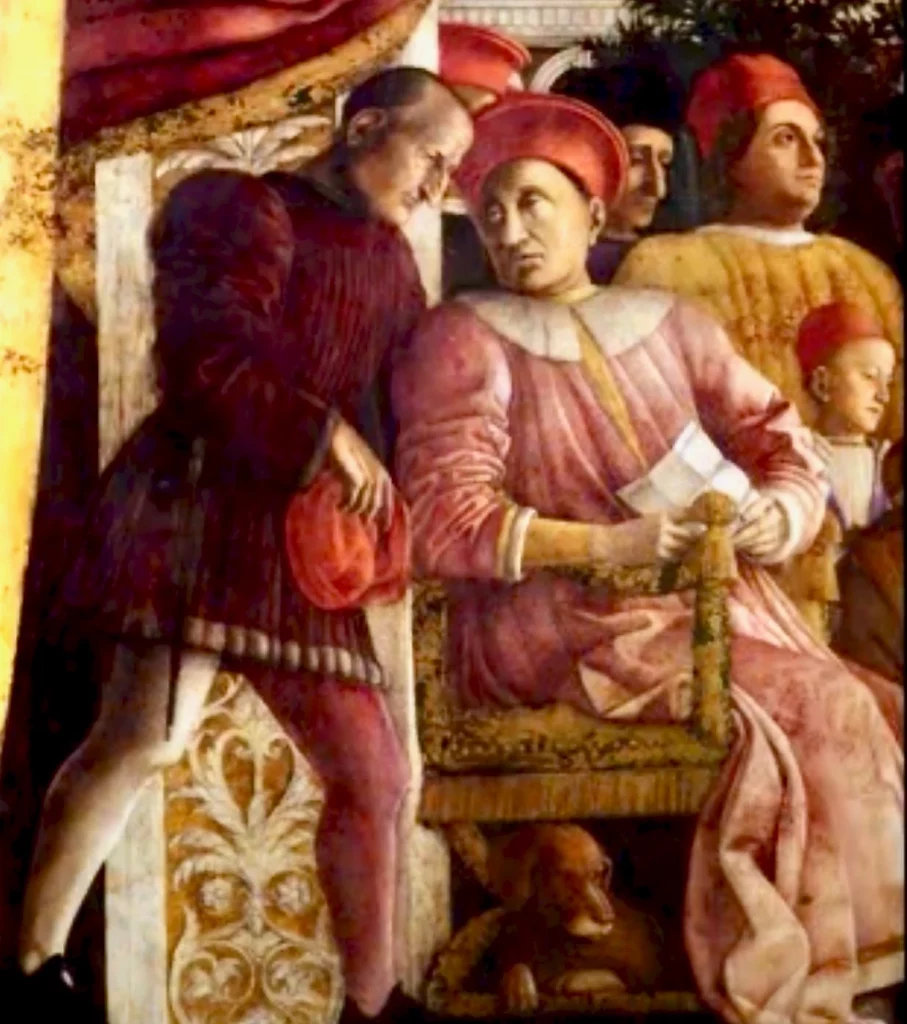
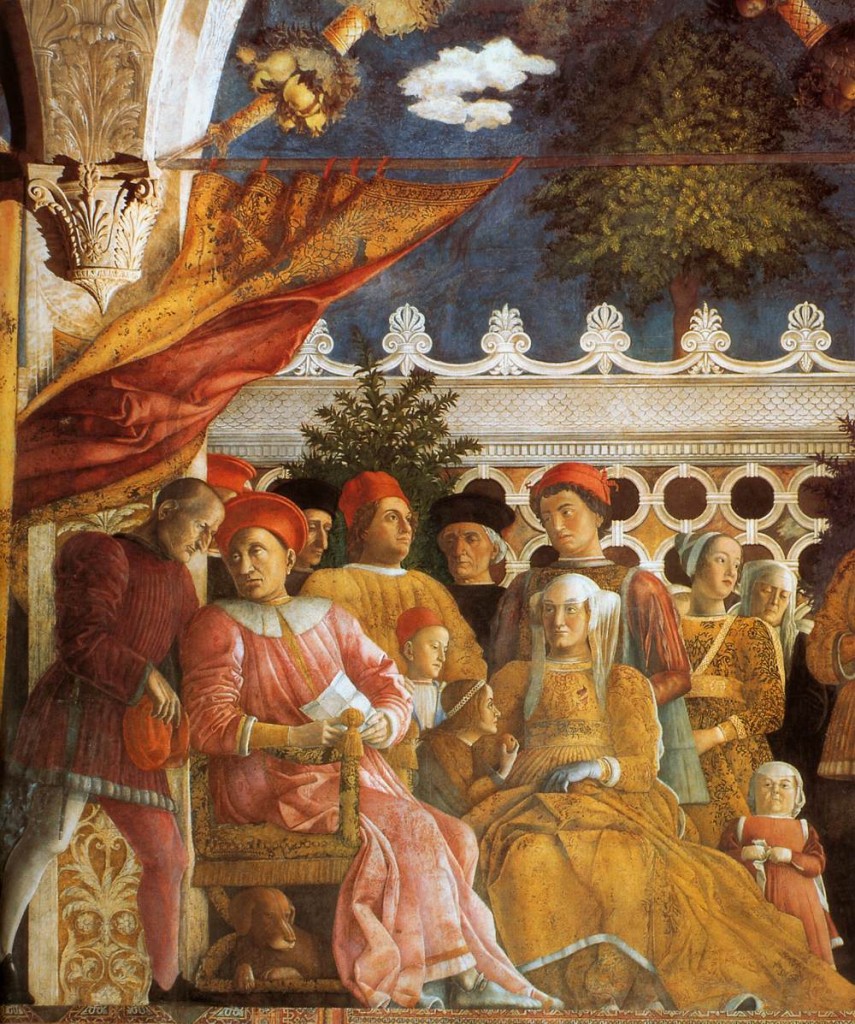
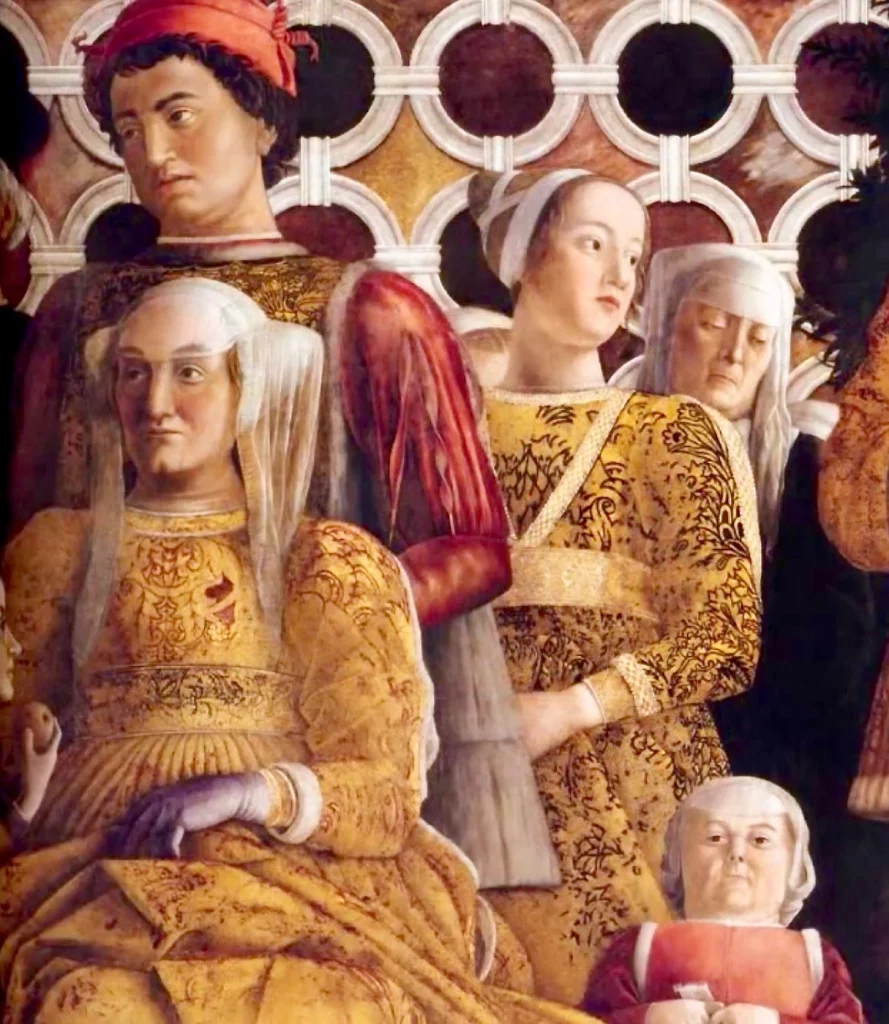
Standing behind her is their son, Frederico, the heir apparent to Ludovico’s throne. To the left, is Ludovico’s second born son Francesco, who was made a cardinal at just 17. Mantegna painted a portrait of Francesco for the occasion, which is now in the Capodimonte Museum in Naples.
To the right is a rather attractive woman, who was Ludovico’s daughter. Next to her mother is a cute little girl named Paolina. And of course, there’s the requisite court jester.
To the right of the family group are men in colored tights. They’re the courtiers and social parasites, making up the royal staff.
2. Western Wall: The Meeting Scene
If you turn to the left, the other wall painted with figures is the Western Wall. The subject of the fresco is referred to as The Meeting. Ludovico III has ridden out of Mantua to greet his son Cardinal Francesco, who is returning from Rome. The fresco is painted as a garden pavilion with landscape scenes between archways and pilasters.
The scene reads left to right. At the far left, you see a dismounted horse. Horses were an important image for the family. The Gonzaga horse stables were the most prestigious in all of Italy.
To the right, the stewards hold back some mastiffs. Pilasters create the illusion of a continuous landscape.
At the top, beautiful little putti (angel) figures hold an inscription plate. Unprecedented in the history of art, they sport delicate butterfly wings. This is one of the best features of the entire room.
On the final compartment on the right, we see the “meeting.” In official robes, Ludovico stands in profile, a position of power. His heir is also in profile. Other ecclesiastics are present.
The vignette is a form of dynastic imagery. It makes the statement that the Gonzagas were power players in both secular and religious affairs.
Understandably proud of his work, Mantegna couldn’t resist adding a personal touch. In one of the pillars, he painted his own self-portrait on a grotesque-style frieze.
3. Ceiling & Oculus: Seminal Illusionist Work
The ceiling is the most celebrated part of the Camera degli Sposi. It’s adorned with fictive, but hyperrealistic, ribs and relief panels to give a sense of decoration over the medieval vaults. Mantegna uses classical elements from Imperial Rome that would go on to dominate the High Renaissance.
The roundels have monochrome medallions of the first eight Roman emperors, from Julius Caesar (technically, a dictator not an emperor) to Otho. They appear to be reliefs, but they’re not.
Mantegna’s use of intense realism and trompe l’oeil effects makes the scene appear to be actual sculptures and architecture. The emperors star down at you head on. Their titles run around the edge of a circle, just as on a coin.
READ: History of Ancient Rome
The most interesting detail is the oculus. The oculus, or eye, is an illusionistic opening in the center of the ceiling, which seems to open to a blue sky.
It’s painted to look like marble surrounded by a garland. It was likely intended to exalt the Gonzaga family by suggesting the heavenly throng were interested in their daily lives.
The balustrade is ringed with little winged putti, servants, and a peacock leaning over a railing. The figures in the illusion look down on the viewer from a cloud flecked blue sky.
To achieve this effect, Mantegna uses the technique of foreshortening masterfully. Foreshortening creates the illusion of an object receding strongly into the distance.
The oculus is very playful. Some putti are smiling. Some are giggling. None are wearing diapers. A large flowered plant rests precariously on a pole, which suggests the plant may come crashing down at any moment.
What Mantega created here was absolutely unique for the 15th century. There’s no comparable piece executed with the precision of foreshortening and the playfulness of the figures.
This oculus gave rise to a whole series of ceiling programs in Italy, including the Sistine Chapel in the Vatican Museums.
READ: Masterpieces of the Vatican Museums
Practical Guide & Tips For Visiting the Camera Degli Sposi in Mantua
Address: Piazza Sordello, 40
Tickets & Prices: Click here for ticket options. To access the Camera, you’ll have to buy a combination ticket for 15 euros.
Pro Tip:
Admission is limited. When you buy your tickets for the Palazzo Ducale, you must reserve a time slot to see the Camera degli Sposi.
There are signs saying you are limited to only 5 minutes in the room. But this won’t be enforced unless it’s high season. You can get very close to the frescos and see all the details.
I hope you’ve enjoyed my guide to the Camera Degli Sposi in Mantua. You may enjoy these other guides to must see art in Italy:
- All the Last Supper Paintings From Renaissance Italy
- Must See Art in Tuscany
- Guide To Rome’s Borghese Gallery
- Guide To Rome’s Capitoline Museums
- Best Museums in Rome
- Best Museums in Florence
- Guide To Free Art in Rome
- Michelangelo’s David Sculpture
- Bernini Guide To Rome
- Caravaggio Guide To Rome
If you’d like to see Mantegna’s spectacular Camera deli Sposi in Mantua, pin it for later.
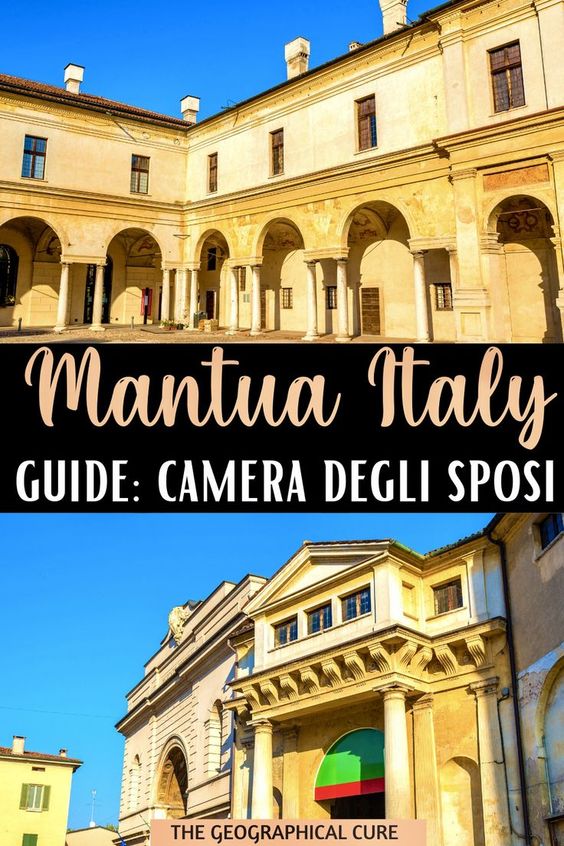

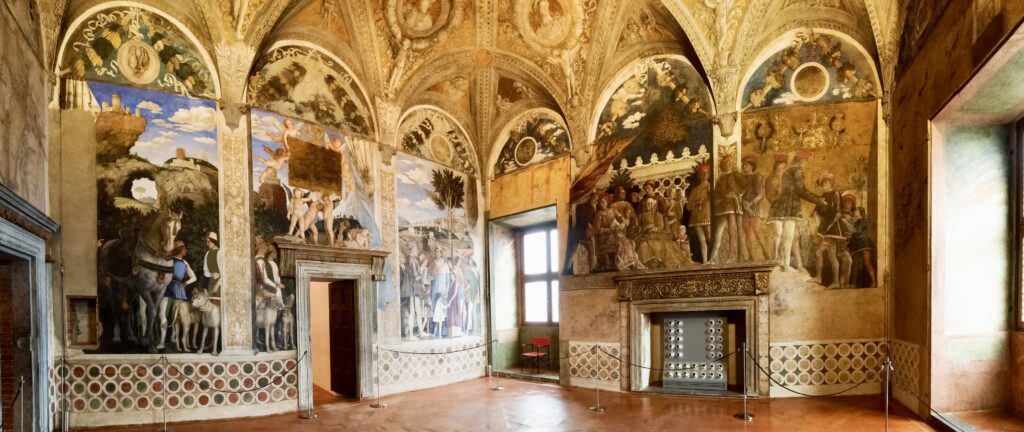
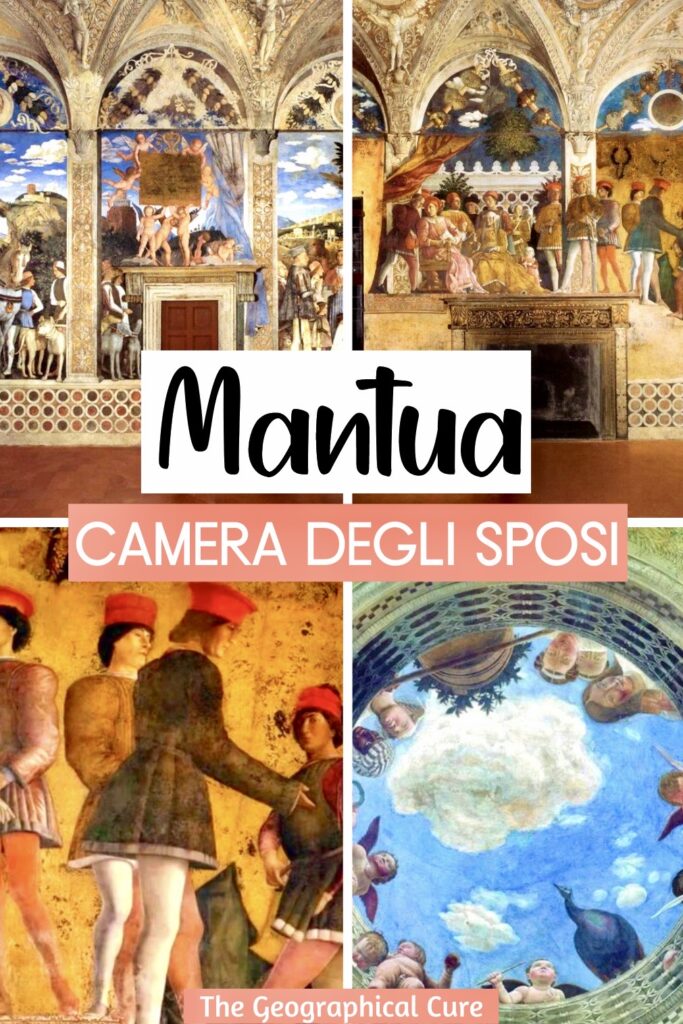
Hi, There is a cloud in the oculus that contains a long, cylindrical object – any thoughts? Thank you!